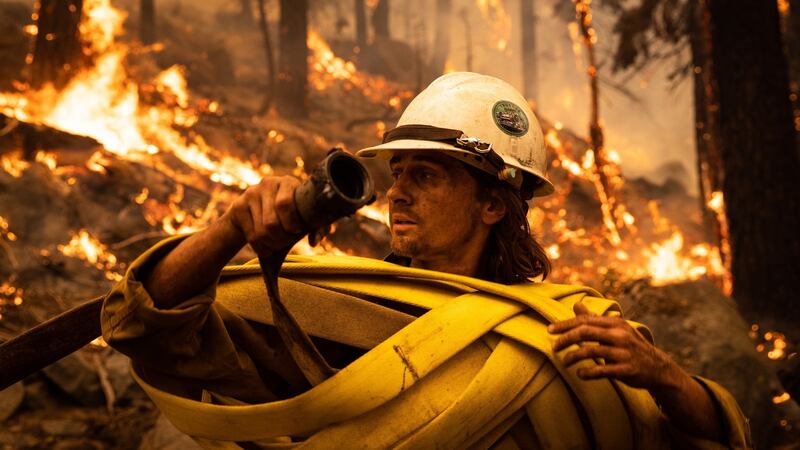Thousands of firefighters are battling to stop a ferocious wildfire from reaching Lake Tahoe in California, after evacuations forced the residents of a popular resort city to flee.
Fuelled by strong winds, the Caldor fire continued its sweep down the slopes of the Sierra Nevada mountains overnight, its footprint swelling to more than 77,500 hectares burned by Tuesday morning. Strong winds had pushed the fire across California highways 50 and 89 the day before, burning several mountain cabins on its path.
“[The fire] did progress into neighbourhoods across highway 89 and has come down off the summit and those areas of Christmas Valley,” Stephen Horner of Cal Fire said on Tuesday morning.
Crews are working "like crazy" to prevent the fire from moving further towards the resort city of South Lake Tahoe, Mr Horner said. But winds are expected to be gusty and conditions will continue to complicate the firefight. "The fuels are just primed for that ignition," he said.

On Monday, thousands of residents and visitors to the town of South Lake Tahoe rushed to leave their homes as the fire drew closer, prompting chaotic scenes and clogged roads.
Monday’s evacuation orders were unheard of in the city, a popular vacation town home to more than 20,000.
“There is fire activity happening in California that we have never seen before,” said Thom Porter, director of the California Department of Forestry and Fire Protection, known as Cal Fire. “For the rest of you in California: every acre can and will burn someday in this state.”
Ash rained down on long lines of cars gridlocked on the roads exiting South Lake Tahoe on Monday. Cars inched along through the smoky haze, some piled high with belongings and others towing trailers with bikes and other recreation equipment. Anxiety mounted with each gusty breeze, strong enough to shake the trees, reminding evacuees of the weather conditions that were fuelling the blaze.

“I haven’t moved in half an hour,” said South Lake Tahoe resident Dick Kline from his truck while stuck in traffic. Trailered behind him, he brought his grandfather’s prized classic car knowing there was a chance that if he left it behind he’d never see it again. “I am sitting here watching all this ash come down on it but at least I am getting it out of here,” he said.
Crews from all over California arrived in the Lake Tahoe basin on Monday, as firefighters make a desperate stand to save the resort communities on the lake and the neighbourhoods tucked into the mountainsides. Many of the new firefighters were immediately dispatched to protect homes in the Christmas Valley area about 16km from South Lake Tahoe, said fire spokesman Dominic Polito.
“We’re flooding the area with resources,” he said. “Wherever there are structures, there are firefighters on the ground.”
Residents across the state line in Douglas county, Nevada, were under evacuation warnings. The Nevada governor, Steve Sisolak, on Monday declared a state of emergency in his state, citing “the anticipation” that the wildfire in the Tahoe area in California would burn across the state line.
The US forest service announced it would be closing down all national forests in California until September 17th. “We do not take this decision lightly but this is the best choice for public safety,” said Jennifer Eberlien, a regional forester.
Fires across the American west
The Caldor fire has scorched nearly 756sq km since breaking out on August 14th. More than 600 structures have been destroyed, and more than 33,500 were threatened. The fire levelled multiple homes on Sunday along Highway 50, one of the main routes to the lake’s south end.
The fire is one of at least a dozen raging across California. More than 15,000 firefighters were battling the fires, including crews from Utah, Washington, Wisconsin and West Virginia, said Mark Ghilarducci, director of California’s office of emergency services.
California has seen an early, and gruelling start to its wildfire season. Mr Porter of Cal Fire said that only twice in California history have blazes burned from one side of the Sierra Nevada to the other, both this month.
The Dixie fire, the second-largest wildfire in state history, has already destroyed 3,121sq km north of the Lake Tahoe-area blaze.
Climate change has made the west much warmer and drier in the past 30 years and will continue to make weather more extreme and wildfires more frequent and destructive, scientists say. – Guardian












